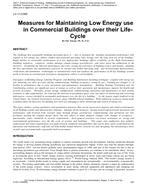Description
The challenge that sustainable buildings movement faces is , “how to maintain the intended sustainable performance with regards to low energy use, indoor comfort and projected operating costs savings over the long term use of the building” Rapid decline in sustainable performance of a few high-profile buildings affects credibility of the High Performance buildings initiatives, reinforces doubts amongst climate-change non-believers and slows down the enthusiasm of the investors. Examining the lifecycle performance and costs, raising the awareness of building owners and tenants, adopting the best operational and maintenance practices by trained and skilled operating staff, and incorporating measurements, verification and automation technologies to automatically track and optimize the performance of all key buildings systems needs to become an essential part of property management culture to avoid pitfalls.
Emergence of Building Energy Labeling Program and Building Information modeling techniques coupled with energy use sub- metering can alert of issues during commissioning, building occupancy, tenant-fit ups , building-use changes or of decline in performance due to poor operations and maintenance management. Building Heating, Ventilation and Air Conditioning systems are significant users of energy as well as their operations and maintenance impacts the health and security of tenants. Therefore, proper design, configuration, commissioning, operations and maintenance of such systems continues to offer opportunities for reducing the emission of greenhouse gases, and any lapses in monitoring and correcting deficiencies creates shortfall in sustainable performance over the life of a building. As the largest single landlord in the United States, the Federal Government oversees about 500,000 federal buildings. With additional resources being made available under the Recovery Act funding, new tools are emerging to allow monitoring and control of energy use.
This paper outlines various qualitative and quantitative measures that can be practiced to improve and sustain performance of all building systems and infrastructure elements. Amongst all the measures, having trained and motivated operations and maintenance staff involved from concepts stage through design, construction, commissioning, and operations not only facilitates meeting the original design intent, but also allows to make adaptive changes with changes in occupancy , functionality, codes, standards or security requirements. Such general practices can assure sustenance of energy and environmental performance over the life cycle of systems and buildings. This paper also emphasizes how industry professional and trade organizations can guide towards standards and guidelines that can be more easily assimilated by the operations and maintenance staff and can help modify human behavior towards not only designing, but maintaining a more socially and environmentally responsible built-environment.
Citation: ASHRAE Conference Papers, Las Vegas, NV
Product Details
- Published:
- 2011
- Number of Pages:
- 8
- File Size:
- 1 file , 610 KB
- Product Code(s):
- D-LV-11-C065




